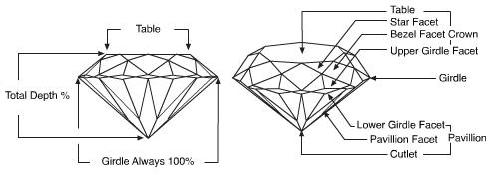The Four C's
Allan's Jewelry - Your source for diamonds.
The Four Characteristics that determine the quality of a diamond.
Two diamonds may, at first glance, look alike, but the truth is that they are very different. Although they may be of equal size, each diamond has characteristics unique to itself, so they may have unique values.
To understand these differences is to understand the 4C’s. Cut, Color, Clarity and Carat Weight. It is the combination of these four characteristics that determines the value of a diamond. Let our diamond experts explain the 4 C’s to you in more detail when you visit our store.
Cut
Many people confuse cut with the shape of a diamond. The shape you select is a matter of individual taste, and today your choice is only limited by the skill and imagination of the craftsman. It is their effort during every stage of the fashioning process that reflects the maximum amount of light back to the eye. Most round, brilliant-cut or fancy-?shaped diamonds possess 58 carefully angled flat surfaces, called facets, whose placement will affect the fire, brilliance and ultimate beauty of your diamond.
How a Diamond handles light
- 1. When a diamond is cut to good proportions, light is reflected from one facet to another and then dispersed through the crown, or the top of the stone.
- 2. If the cut of the diamond is too deep, some light escapes through the opposite side of the pavilion, or bottom.
- 3. If the cut is too shallow, light escapes through the pavilion before it can be reflected.
The different facets of a round, brilliant-cut diamond
The seven most popular shapes of a diamond.
 |
 |
 |
 |
 |
 |
 |
| Brilliant | Marquise | Pear | Emerald | Oval | Heart | Square |
Color
The most prized diamonds are colorless diamonds, because their beauty depends entirely upon their remarkable optical properties. In such diamonds, all the colors of the rainbow are reflected back to your eye. While the majority of gem diamonds appear to be colorless, others can contain increasing shades of yellow to brown, some of which are referred to as champagne diamonds. Other diamonds of exceptional color – red, blue, green, pink, and amber – are knows as “Fancies.”
The color grading scale varies from totally colorless to light color or tinted. The difference between one grade and its neighbor is very subtle. Experts never try to remember color; they use master diamonds of know color for comparison.
| E | F | G | H | I | J | K | L | M | N | O | P | Q | R | S | T | U | V | W | X | Y | Z |
| Colorless | Near Colorless | Faint Yellow | Very Light Yellow | Light Yellow | |||||||||||||||||
|---|---|---|---|---|---|---|---|---|---|---|---|---|---|---|---|---|---|---|---|---|---|
Clarity
Because of their unique optical properties, diamonds, more than any other gemstone, are capable of producing the maximum amount of brilliance. While minute crystals of diamond or other minerals are contained in almost all diamonds, a diamond that is virtually free of inclusions and surface markings will be judged as flawless. In these diamonds, nothing interferes with the passage of light or spoils the beauty. But these diamonds are extremely rare and will command a high price.
To determine a diamond’s clarity grading, it must be examined under a 10x magnification by a trained, skilled eye. What minute inclusions there may be make every diamond unique. These are, in fact, nature’s fingerprints and do not mar the diamond’s beauty nor endanger its durability. Without high magnification, you may never see these inclusions. However, the fewer there are, the rarer your diamond will be.
| FL | IF | VVS1-VVS2 | VS1-VS2 | SI1-SI2 | Il-I2-I3 |
 |
 |
 |
 |
 |
 |
| Flawless | Internally Flawless minor surface blemishes |
Very Very Small Inclusions |
Very Small Inclusions |
Small Inclusions | Inclusions: Visible to the naked eye |
Carat Weight And Total Carat Weight
With all precious stones, the weight and therefore the size, of a diamond is expressed in carats. That is abbreviated as CT or CTTW.
One carat is divided into 100 “point” so that a diamond of 25 points is described as a quarter of a carat or 0.25 carats. Size is the most obvious factor in determining the value of a diamond, but now you know that two equal sizes can have very unequal prices depending on their quality. However, remember that diamond of high quality can be found in all size ranges. Here are some other examples that show that approximate size of diamonds of varying carat weights.
 |
 |
 |
 |
 |
 |
 |
 |
 |
| 0.25 CT | 0.50 CT | 1.00 CT | 1.25 CT | 1.50 CT | 1.75 CT | 2.00 CT | 2.50 CT | 3.00 CT |





